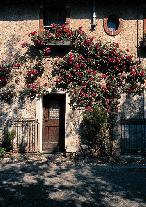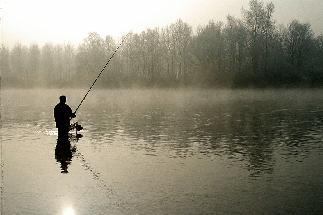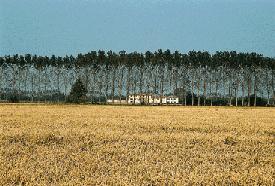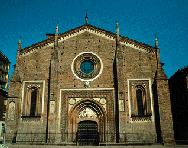 HP Short Guide HP Short Guide |
 HP Short Guide HP Short Guide |
 Sforzesca, the hunting residence and farm built on the orders of Ludovico il Moro in 1486, is in the immediate vicinity of Vigevano and rises up on a high natural terrace which overlooks the Ticino valley.
In terms of structure, it is reminiscent of a traditional castle lay-out with four walls around a central courtyard which is almost square in shape and has four large buildings, known as "colombaroni", one at each corner.
These are decorated with ogival windows and jagged-edged friezes.
The residence is surrounded by an expanse of cultivated land, irrigation channels and water-mills designed by none other than Leonardo da Vinci who was a guest here at the end of the fifteenth century.
Noteworthy are also the typical Via dei Fiori, bordered by the traditional country-houses, the Groppallo-Saporiti Villa dating back to the end of XVII century and the neo-classic church of Saint Anthony, rich with works of art.
Sforzesca, the hunting residence and farm built on the orders of Ludovico il Moro in 1486, is in the immediate vicinity of Vigevano and rises up on a high natural terrace which overlooks the Ticino valley.
In terms of structure, it is reminiscent of a traditional castle lay-out with four walls around a central courtyard which is almost square in shape and has four large buildings, known as "colombaroni", one at each corner.
These are decorated with ogival windows and jagged-edged friezes.
The residence is surrounded by an expanse of cultivated land, irrigation channels and water-mills designed by none other than Leonardo da Vinci who was a guest here at the end of the fifteenth century.
Noteworthy are also the typical Via dei Fiori, bordered by the traditional country-houses, the Groppallo-Saporiti Villa dating back to the end of XVII century and the neo-classic church of Saint Anthony, rich with works of art.
 Lomellina is the name given to the area bounded by the Sesia, Po and Ticino rivers and their springs.
This fertile and luxuriant area has roots which go way back in history.
It was mentioned by Pliny and by famous historians who handed down tales describing the exploits of the region's dynamic and strong-willed people.
Thanks to the natural abundance of water, rice has been grown here since as long ago as 1500.
As the centuries went by rice farming became one of the most important activities in the area.
As in Vigevano, Mortara, Lomello and Sartirana, there are illustrious works of art to discover and admire in all the towns of the Lomellina region.
Lomellina is the name given to the area bounded by the Sesia, Po and Ticino rivers and their springs.
This fertile and luxuriant area has roots which go way back in history.
It was mentioned by Pliny and by famous historians who handed down tales describing the exploits of the region's dynamic and strong-willed people.
Thanks to the natural abundance of water, rice has been grown here since as long ago as 1500.
As the centuries went by rice farming became one of the most important activities in the area.
As in Vigevano, Mortara, Lomello and Sartirana, there are illustrious works of art to discover and admire in all the towns of the Lomellina region.
Lomello is an ancient town which was founded by the Celts. It prospered in Roman times and during the Longobardic period. In 590 a.d. Queen Teodolinda and Duke Agilulfo met and probably married here. Towards the year 1000, the town became a powerful stronghold of the counts palatine, and was destroyed and rebuilt several times. The remains of the ancient walls can still be seen, and the town boasts some remarkable medieval monuments such as the religious building complex which comprises the Basilica di Santa Maria Maggiore, an important early Lombard Romanesque construction (eleventh century), and the Battistero di San Giovanni ad Fontes, (fifth century - seventh century), an ancient Longobardic building which still has the remains of the original baptismal font. At Lomello, there is also the treasured Romanesque church of San Michele (twelfth century) and the castle (fifteenth century) where you can admire frescos of fine workmanship. (Guided tours from March to October an Sundays and Holidays from 3.00 p.m. to 6.00 p.m.)
Cozzo, which goes by the name of Cuttiae in ancient Roman itineraries, has a Castle as early as the year 1000. The fort was modified to its present form in the second half of the fifteenth century when it became the property of Pietro Gallarati whose family are still the owners today.
 Sartirana was known as Terraforte in the Middle Ages.
It later became the estate of Cico Simonetta, a famous counsellor to Francesco Sforza.
The castle was rebuilt by Jacopo Dal Verme and altered in the second half of the fifteenth century.
It was Dal Verme who was responsible for the twelve-sided tower with deep embrasures which still stands today.
It now serves as a venue for exihibitions and conventions.
Sartirana was known as Terraforte in the Middle Ages.
It later became the estate of Cico Simonetta, a famous counsellor to Francesco Sforza.
The castle was rebuilt by Jacopo Dal Verme and altered in the second half of the fifteenth century.
It was Dal Verme who was responsible for the twelve-sided tower with deep embrasures which still stands today.
It now serves as a venue for exihibitions and conventions.
Together with the medieval castle (twelfth - fifteenth century) which belonged to the Marquis of Olevano, you may see the Country Arts Museum, lodged in an old cowshed with hay-loft. The Museum collection is constituted by farm implements and craft tools used in the Lomellina region until 1950. They are exhibited in reconstructed cowshed, dairy and other workshops.
 It is an important centre for agriculture and industry.
The town has ancient medieval origins and is famous for its sixteenth century Gothic Cathedral which is dedicated to San Lorenzo.
The cathedral has a nave and two aisles.
Here you can see valuable paintings by Bernardino Lanino, by Gaudenzio Ferrari and of the seventeenth century Lombard school.
At the Chiesa di Santa Croce, which was rebuilt in 1596 by the architect Pellegrino Tibaldi, you can see some fascinating frescos.
Tradition has it that the Sant'Albino abbey was founded by Charlemagne.
It was restored in the sixteenth century and inside there is a fifteenth century Giovanni da Milano fresco.
It is an important centre for agriculture and industry.
The town has ancient medieval origins and is famous for its sixteenth century Gothic Cathedral which is dedicated to San Lorenzo.
The cathedral has a nave and two aisles.
Here you can see valuable paintings by Bernardino Lanino, by Gaudenzio Ferrari and of the seventeenth century Lombard school.
At the Chiesa di Santa Croce, which was rebuilt in 1596 by the architect Pellegrino Tibaldi, you can see some fascinating frescos.
Tradition has it that the Sant'Albino abbey was founded by Charlemagne.
It was restored in the sixteenth century and inside there is a fifteenth century Giovanni da Milano fresco.
 HP Short Guide HP Short Guide |